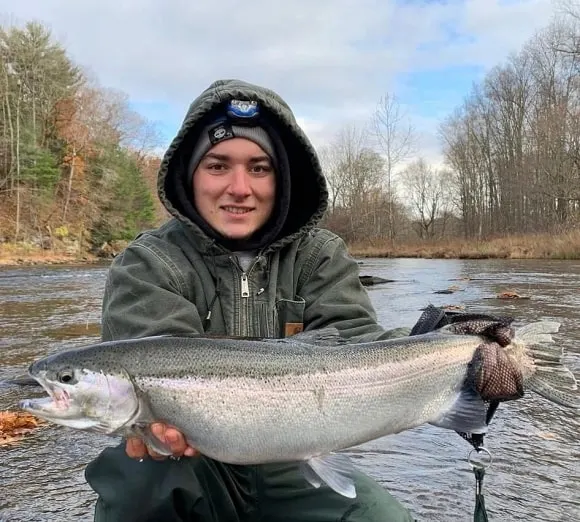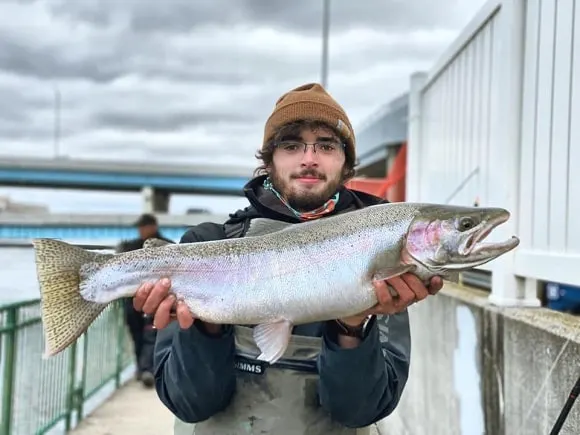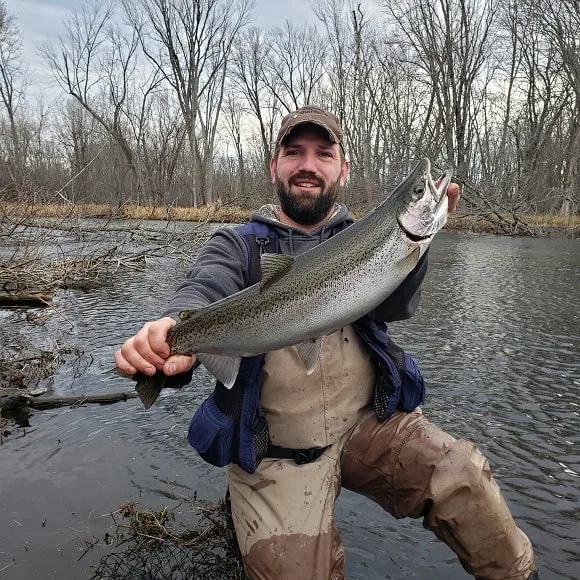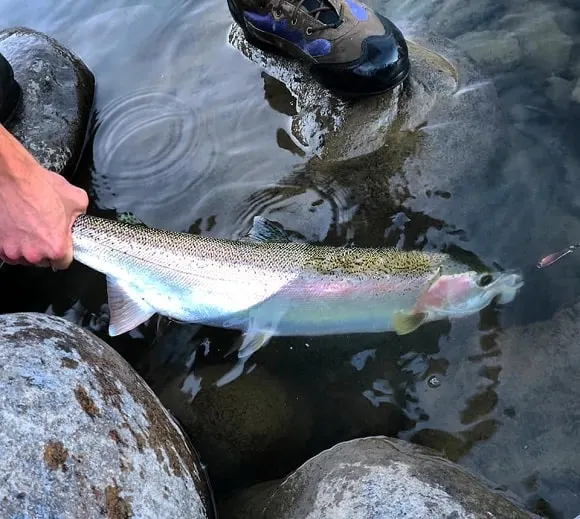I immediately think of the Great Lakes tribs and their awesome steelhead runs when I hear Michigan!
Undoubtedly, the state is home to some of the world’s best steelhead fisheries, and every year, thousands and thousands of anglers come here to fish for this most magnificent of fighters!
To help you plan and experience the ultimate fishing adventure, I put together this complete guide on steelhead fishing in Michigan.
It includes the following information:
- Best steelhead rivers in Michigan
- Best time of year to catch steelhead
- Best steelhead fishing charters (rivers and Lake Michigan)
- Details about fishing reports, regulations, and licenses
Keep reading this article and get all the essential info you need for your upcoming Michigan steelhead trip. Tight lines!
PRO TIP: Need to gear up for your next steelhead adventure? Then check out this quality equipment on Amazon. It’s very cost-effective, durable, and will get the job done every time!
Where Is the Best Steelhead Fishing in Michigan?

Michigan has steelhead written all over it! There are plenty of rivers, streams, and creeks that are home to colossal steelhead runs, and some of them are considered to be the best trout fisheries in the entire country.
It would literally be impossible to list all of Michigan’s best steelhead waters and spots, so I’ve narrowed it down to the state’s best-producing and most popular waters.
So if you’re planning a steelhead trip to Michigan, make sure to check out the following hot spots:
Manistee River (Northwestern Michigan)
Imagine a 190-mile-long river system that’s full of steelhead for several months!
The Big Manistee is, without a doubt, one of Michigan’s finest steelhead rivers.
This Lake Michigan tributary enters the lake at the little city of Manistee in the northwestern parts of Michigan. It then runs 190 miles through the state’s northwestern lower peninsula.
Most steelhead get caught in the lower stretches of the river up to Tippy Dam in Wellston.
Here, massive numbers of them gather throughout the spawning season, and fishing for them in this area is hence considered somewhat easier, so tourists and beginners like to fish on Tippy.
However, plenty of other spots along the river offer excellent accessibility and fishing, both from shore, with waders, or from a boat.
Grand River (Southwestern Michigan)

With 252 miles, the Grand is one of the state’s longest rivers and another of Lake Michigan’s major tributaries that offers excellent fishing for steelhead.
The Grand River is located in the southwestern parts of Michigan’s lower peninsula and empties into Lake Michigan at Grand Haven.
Most of the fishing takes place in the river’s lower stretches up to Grand Rapids.
If you’re looking for a steelhead adventure in an urban environment, fishing in downtown Grand Rapids and its Street Dams is the perfect address for you!
The city’s Sixth Street Dam, in particular, is a popular hot spot among cars and buildings that can hold plenty of decently sized fish!
Muskegon River (Western Michigan)

The Muskegon is yet another of Michigan’s big trout rivers and one that offers numerous great spots to fish for steelhead.
Muskegon River is located in the western part of the state’s lower peninsula. It has its mouth at Muskegon, where it empties into Lake Muskegon, a water body connected to Lake Michigan.
The entire lower stretch up to Croton Dam offers fantastic steelhead fishing opportunities, and thanks to the Muskegon’s enormous size, it’s relatively simple to find spots that aren’t overcrowded.
Both fishing from shore and boat can yield great results, and there are quite a few trophy steelhead to be caught in the Muskegon!
Pere Marquette River (Western Michigan)
The Pere Marquette is yet another Lake Michigan tributary that is well-known for its excellent trout and steelhead fishery.
Emptying into Lake Michigan at Luddington, this is one of the state’s most scenic rivers. In fact, the Pere Marquette is listed as a National Scenic Waterway by the US Department of Agriculture.
The beautiful PM runs freely for over 60 miles, making it the longest dam-free river system in the entire Michigan lower peninsula.
As much of the Pere Marquette is marked as flies only, this river is the perfect pick if you’re into fly fishing for steelhead.
Lake Michigan
If you prefer fishing for steelhead during the warmer months of the year and on a lake rather than a river system, The Great Lakes, and Lake Michigan in particular, offer incredible fishing opportunities during the summertime.
Trolling for steelhead on one of the bigger charter boats is great fun, and you don’t have to worry about the snow, ice, and cold.
As a bonus, you get the chance to hook up to a real Great Lakes giant, be it steelhead, king, or coho!
Honorable Mentions
- Au Sable River (Lake Huron trib in the northeastern part of Michigan)
- St Joseph River (close to the Chigaco area in the southern part of Michigan)
- Clinton River (Lake St Clair trib in the Detroit area)
When Is the Best Time to Fish for Steelhead in Michigan?
Michigan has three major steelhead seasons that produce plenty of fish and bites in the state’s many Great Lakes tributaries.
Late Fall
The first one occurs during late fall and stretches from October through December when the fish start to make their so well-known runs up the rivers.
Now, at the very beginning of their spawning journey upstream, the fish are full of energy and, in fact, very hungry.
Among other things, they will feast on the eggs of the spawning chinook that are now also found in the rivers, which is something to keep in mind when choosing your lure or bait!
Mid-Winter
The second one is the mid-winter steelhead season, stretching from January through early March.
The rivers that remain free of ice are getting loaded up with more and more steelhead coming up from Lake Michigan and Huron.
They join the ones already overwintering here in the tributaries, resulting in significant amounts of fish.
So, if you can stand the cold and keep to the bigger river systems that do not freeze over, you’re up for a real treat!
And as a bonus, you will have most of the river stretches to yourself, as only few anglers will target steelhead during mid-winter.
Spring
The third period to fish for Michigan steelhead occurs during spring, from March through May, and is considered the very best time of year to target migrating steelhead.
All the major Great Lakes tribs are now bursting with steelhead, and many of them have yet to spawn.
That spells fantastic fishing opportunities and a good chance of netting yourself a real trophy steelhead!
Most fish will spawn sometime in April in the smaller rivers, while the spawning often occurs in May in the larger river systems.
Can You Catch Michigan Steelhead in Summer?
Steelhead that run during summer (also called Skamania) aren’t as abundant as their fall, winter, and spring-run counterparts, but some rivers get a fair amount of them during the hotter months of the year nonetheless.
The best address for river fishing Skamania is the Manistee River’s Tippy Dam.
You can also fish for summer steelhead directly on the Great Lakes, as the fish now gather in the lakes’ shallower areas and around the mouths of its tributaries and creeks before starting their annual runs.
Both Lake Michigan and Lake Huron can produce decently sized summer steelhead, and more than a few fish can weigh well over 10lb.
How to Fish for Steelhead in Michigan?

Michigan’s rivers will have high water levels, fast currents, and high turbidity during the steelhead season.
This means that you will have to adjust your techniques, baits, and lures accordingly.
Three methods have proven most productive when fishing for steelhead in running water during the fall, winter, and spring seasons:
Spin Fishing
Use the rivers’ strong currents to your advantage and fish with lures that give off a lot of movement and vibration when retrieved against the flowing water.
Jointed crankbaits, large inline spinners, or double-bladed spinners can be very productive lure choices.
GEAR TIP: Need to gear up for the season? Take a closer look at this popular steelhead spin fishing gear on Amazon!
Float Fishing
When targeting deeper holes or backwaters, using floats (or bobbers) can be deadly for steelhead!
It’s a simple yet highly effective method to catch them on natural baits.
If you put floating Chinook spawn sacks or eggs, you’re practically guaranteed to hook up to a good bunch of steelhead during your trip!
GEAR TIP: You can check out this float rod and reel combo on Amazon. It’s perfect for both steelhead and salmon!
- Rod: 10′ Okuma Celilo Graphite
- Reel: Pflueger President XT40
Fly fishing
As most steelhead will gorge on salmon eggs and fry during their runs, you should try to match the hatch by fishing with flies or streamers that imitate salmon fry and eggs.
Additionally, Michigan steelhead love stoneflies, which is another great pick when hitting the rivers!
GEAR TIP: Check out this awesome rod and reel combo on Amazon. It’s very decently priced and the perfect entry-level gear! And don’t forget your waders!
- Fly Rod and Reel Kit: TFO NXT Black Label 4-piece
- Waders: Tidewe 1600g Insulated Waders
Can You Fish Steelhead at Night in Michigan?
Night fishing for steelhead has become very popular in Michigan and can yield excellent results if you know how to go about in the dark.
For some anglers, night fishing has become a way of avoiding the crowds during the daytime (for example, at the Manistee River’s Tippy Dam).
For others, it’s simply a welcome change and challenge.
No matter the reason, nighttime steelhead fishing has become a lifestyle for many anglers in Michigan, also because chances of catching a really big fish are sometimes better during the dark hours of the day.
It must, however, be mentioned that night fishing in the smaller rivers should be avoided, as you can easily get snagged in trees or bushes in the dark if you don’t have enough space to cast your fly or spinning rod.
Also, if you’re not familiar with the river you’re fishing in, wading around in it at night is not a good idea either!
If that’s the case, keep to daytime fishing and don’t take unnecessary risks! No steelhead is worth your life!
Michigan Steelhead Fishing Reports
The Michigan DNR releases up-to-date fishing reports from around the state every week. It’s a great resource to keep updated and plan upcoming fishing trips.
Check out the weekly fishing reports at Michigan.gov here
Additionally, there are a few local guides that frequently publish fishing reports for the most popular steelhead rivers in the state:
- Manistee River and Pere Marquette River fishing reports
- Muskegon River fishing reports
- Grand River fishing reports
Michigan Steelhead Fishing Regulations
Michigan is blessed with abundant fish populations and a great variety of trout species.
As the fishing for these trout types is so immensely popular here, there are many important rules and regulations regarding the how, when, and where of trout fishing in Michigan.
Make sure to read all of the state’s trout fishing regulations carefully and thoroughly before your planned trip!
Do You Need a Fishing License in Michigan?
All resident and nonresident anglers age 17 or older must purchase a valid fishing license in the state of Michigan.
You can buy your fishing license both online and in designated stores all over the state.
How Big Do Steelhead Get in Michigan?
Steelhead that are found in the Great Lakes can grow to very respectable sizes.
With the right conditions, these fish can measure well over 35” and weigh more than 20lb, even though steelhead of such sizes are not caught very often in Michigan waters.
The average Michigan lake and river steelhead will have an approximate length of 20 to28” and a weight of 3 to 8lb.
RELATED READING: Best Salmon Fishing in Michigan (A Helpful Angler’s Guide)
What Is the Biggest Steelhead Ever Caught in Michigan?
The Michigan state record steelhead (or rainbow trout) is a giant fish of 26lb 8oz.
Angler Mark Johnson caught this behemoth on Lake Michigan in 1975.
It’s an old record, but the chances are good that there are even bigger steelhead out there in the depths of Lake Michigan!
Are Steelhead Native to Michigan?
Steelhead trout are not native to the state of Michigan. They were first introduced to a few of Lake Michigan’s smaller tributaries in 1876 and have since spread to all of the Great Lakes and their streams and tributaries.
The main reason for those first stocking attempts was to bolster the state’s recreational and commercial fishing. And if you look at Michigan’s steelhead fishing past and present, you’ll know that this attempt has been more than fruitful.
It is here, in Michigan’s numerous river systems, that the steelhead have their annual run and spawn, attracting thousands and thousands of sport anglers from all over the world.
In just a little over 100 years, this fish species has managed to reproduce and establish self-sustaining populations all over Michigan.
And even though Michigan steelhead never reach the sea, research has found that the state’s steelhead populations actually treat the Great Lakes as a surrogate ocean, which is nothing less than an evolutionary masterpiece!
Related Articles
- Steelhead vs. Salmon (How Do You Tell Them Apart?)
- Steelhead Fishing in New York (Everything You Need to Know)
- Are Rainbow Trout and Steelhead the Same?
Featured image courtesy of Michigan Guide Services

